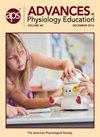将肌肉纤维产生的细胞外电位模拟为卷积系统的输出信号
IF 1.7
4区 教育学
Q2 EDUCATION, SCIENTIFIC DISCIPLINES
引用次数: 0
摘要
生理学教育进展》,印刷版前。本文章由计算机程序翻译,如有差异,请以英文原文为准。
Modelling the extracellular potential generated by a muscle fiber as the output signal of a convolutional system
Advances in Physiology Education, Ahead of Print.
求助全文
通过发布文献求助,成功后即可免费获取论文全文。
去求助
来源期刊
CiteScore
3.40
自引率
19.00%
发文量
100
审稿时长
>12 weeks
期刊介绍:
Advances in Physiology Education promotes and disseminates educational scholarship in order to enhance teaching and learning of physiology, neuroscience and pathophysiology. The journal publishes peer-reviewed descriptions of innovations that improve teaching in the classroom and laboratory, essays on education, and review articles based on our current understanding of physiological mechanisms. Submissions that evaluate new technologies for teaching and research, and educational pedagogy, are especially welcome. The audience for the journal includes educators at all levels: K–12, undergraduate, graduate, and professional programs.

 求助内容:
求助内容: 应助结果提醒方式:
应助结果提醒方式:


